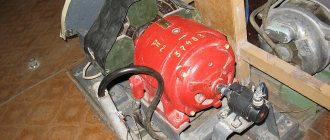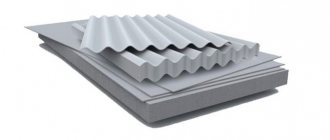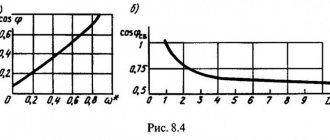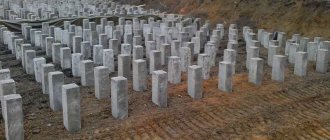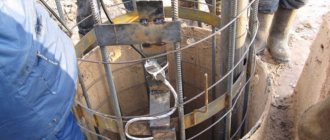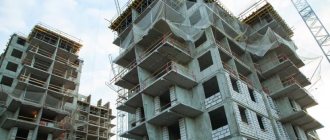Pile foundations are becoming increasingly popular in the construction of country houses and industrial buildings. The versatility of such a foundation, fast construction and reasonable price are the main advantages when choosing over other foundation construction technologies.
Piles are considered a solid foundation that is not susceptible to changes in ground level and its condition. A key factor in the stability of such a foundation is the appropriate method of driving the piles. An important criterion for stability is the fixity of the main structure.
When and why is it necessary to press in piles?
It is advisable to use pile technology for a significant amount of work. When the number of supports is designed on a large scale, this technology is the optimal solution for installation. Indentation makes it possible to significantly reduce construction time and financial expenses for the construction of all supports.
The advantages of the method will determine the list of construction sites on which it is used. During construction work in the city, deepening supports will be advisable in the following situations:
- construction next to old buildings;
- carrying out work in recreation areas;
- subject to existing restrictions on the implementation of shock work;
- at a short distance from adjacent existing buildings;
- in a region where there is a risk of landslides;
- when the site has a significant relief slope;
- work in historical places.
Piling machine (hydraulic hydrostatic pile driver)
Diagram of a pile pressing machine.
A machine of this type consists of a main frame (the following installations are mounted on it: machine moving, crane and piling) and a load frame, which serves to secure anchor loads. Two mountings of the pile-pressing installation, lateral and central, allow you to work in close proximity to existing buildings.
Such equipment is a functionally complete mechanism, the operation of which does not require auxiliary equipment.
The operating technology of a pile-pressing machine is as follows: disassembled equipment is delivered to the construction site, the preparation of which takes much less time than for the operation of a pile-pressing machine. To do this, just rough leveling the site and marking the indentation points is enough. In this case, the site may even have a slight slope (up to 15%), since during the operation of the machine, thanks to the available hydraulic cylinders, this defect will be eliminated. In addition, the entire process of pressing in is completely controlled; accordingly, after it has been carried out, there is no need for additional static tests of the installed elements.
Of course, the cost of such a machine is quite high, but since it includes a chassis, a crane, and a pile-pressing installation, this cost is quite adequate and does not exceed the total cost of all this equipment.
Advantages of the pile pressing machine:
- no additional equipment is required to build the foundation;
- absence of vibration and shock loads on the ground and buildings and structures located in the immediate vicinity;
- no need for leader wells;
- no need to take additional measures to prepare the site for work;
- high speed of work.
Diagram of pile elements.
To be fair, it should be noted that this technology also has some disadvantages:
- It is not always possible to carry out work on small construction sites due to the size of the equipment used;
- delivery to the construction site requires much more equipment, which increases the cost of transportation;
- the cost of driving one linear meter exceeds the price of driving, for example, driven piles.
Thus, the construction of a pile foundation by pressing piles is the most progressive way of carrying out work. It is characterized by energy intensity, high productivity and speed of work, and allows you to avoid additional work on preparing the construction site. Progress does not stand still, and along with it the number of methods used in construction is growing.
In each specific case, you should choose the one that will meet the needs of the building and the possibilities of using certain equipment.
Advantages and disadvantages
Pile technology has virtually no disadvantages. The most significant advantages of this technology are:
- significant material consumption - when the supports are deepened, the surrounding soil is compacted, thereby increasing the reliability of the foundation and reducing the cost of construction;
- the technique makes it possible to monitor work on a computer - the design load is determined for all supports separately, which increases the quality and strength of the foundation;
- low energy intensity of the work - since electrical energy will be used, and not flammable or lubricating materials;
- the ability to install the base in any soil;
- the ability to reduce the time for installing supports by pressing;
- increasing the strength of the base in the process of applying the immersion technology - for this purpose, factory-produced elements are used, which prevents damage to the integrity of the piles during indentation;
- there are no shock or vibration loads on the soil;
- low noise level during work.
Pressing piles has a number of disadvantages:
- the technology is unsuitable for rocky soil;
- the price of pressing 1 linear meter is mainly higher than when using driven piles;
- To deliver the equipment, a lot of equipment will be required, which will increase the cost of transportation.
Pressing in the piles will make it possible to build a foundation next to residential buildings and other structures. Particularly where installation using vibration or impact methods is not possible.
Indentation of piles: advantages and features of technology
Driving piles using the indentation method has many advantages and almost no pronounced disadvantages. Among the objective advantages of the technology:
- Material consumption, since during the immersion of piles the soil around is compacted. This guarantees an increase in the reliability of the base coupled with a reduction in price.
- The method makes it possible to monitor the indentation force in real time, determining the actual load for each pile. This ensures quality, high load-bearing capacity and strength of the base.
- Indentation guarantees low energy consumption of work, since electricity is used, not fuels and lubricants.
- Driving piles into any soil is possible, which makes the technology universal.
- The installation of piles by indentation significantly saves time due to the high pace of work.
- The strength of the foundation is increased through the use of high-quality factory-made reinforced concrete piles and a gentle influence on them during the pressing process. This prevents damage to the integrity of the piles.
- There are no additional loads on the soil (shock, vibration). This reduces the negative destructive impact on neighboring objects, structures and buildings, especially if there are requirements for their safety.
- Pressing in the piles ensures a low noise level.
- Installation, as a rule, does not require leader drilling.
- The minimum number of preparatory measures before the start of work.
You need to know this: IEDs work effectively in any soil (including water-logged soil), which expands the horizons and possibilities of their use in the construction process.
It cannot be said that driving piles using the indentation method has disadvantages. These are features that should be taken into account based on existing conditions:
- The technology is not suitable for working on rocky soil.
- Special equipment is required for driving piles. This increases the cost of transportation, but the costs are offset during the construction process.
At the same time, indentation of piles allows the construction of foundations in close proximity to residential buildings in use and other structures.
Piles used
For driving, all types of piles made of reinforced concrete and rolled metal are used, including composite type supports. Piling installations are capable of working with the following types of piles:
- solid square sections;
- square sections are hollow inside;
- round with cavity;
- shells.
The indentation technology is appropriate if composite supports are used, because in such a situation the degree of immersion is not limited by the viscosity of the structure. This is observed when driving supports with diesel hammers. Composite piles are buried more than 40 m.
Technology of the method of static indentation of piles
The essence of the static pressing technology is that the VCA, using its own crane, installs the pile at the design point of the pile field using a hydraulic press, presses it to the required depth. In this case, the control device of the VCA will control the pressing force and, after achieving the required pressing force, will stop driving the pile. The VU can load both solid finished and prefabricated piles (reinforced concrete piles, steel, wood), sheet piles, pipes and other elements for the same purpose.
The technology for pressing piles contains the following stages:
1. Preparatory work.
2. Production cycle.
3. Acceptance tests and a documented report on the work done.
4. Cutting down the pile heads.
Preparatory stage
The essence of the work being carried out:
1.1. Our company’s engineers develop and agree with the client a work plan:
— work schedule for driving test piles and conducting their static tests;
— schedule for delivery of finished piles or their manufacture at the construction site;
— route of movement of the IED around the site;
— requirements for the foundation pit and its arrangement;
— warehouse locations for temporary storage of piles and deployment of IEDs;
- diagrams of access roads and driveways.
1.2. IEDs and other necessary special equipment are being “mobilized.” The construction site is accepted and its engineering preparation is carried out:
— geodetic survey of the site and marking of the future pile field;
— acceptance of benchmarks and main axes of the building;
— construction of temporary access roads, installation driveways and technological roads;
— arrangement of a construction site with a storage area for piles and their elements;
— delivery and placement of temporary inventory (mobile) buildings for storage, production, administrative and household purposes.
At the described stage, it is necessary to ensure, first of all, the purchase and delivery to the construction site of the press-in elements (immersion elements) established in the design documentation. These listed elements are most often piles (steel, concrete, reinforced concrete and pipe concrete) or sheet piles (steel pipes, rolled steel or reinforced concrete sheet piles with a “U” or “Z” shaped profile).
In recent years, piles that use a so-called “lost shoe” during immersion have become quite popular and used in recent years. The essence of this technique is that a hollow metal pile is immersed inside the soil - a casing pipe, which begins with a removable conical head (“lost shoe”). After reaching the required depth and the required (in terms of density) layers of soil, a reinforcement structure made of longitudinal and transversely directed reinforcing bars is installed inside the pile. Then concrete mortar is poured through the upper end and the pile casing pipe is removed. Under the pressure of the concrete solution, the “lost shoe” is separated from the casing, which, when removed, is subjected to vibration to accelerate the process of concrete compaction in the resulting reinforced concrete pile. If necessary, you can vibrate not the casing pipe, but the reinforcing grid. As a variant of the process, it is possible to immerse the reinforcement structure into a well already filled with concrete mortar. To organize the continuous installation of such piles, the preliminary delivery of casing pipes, production at the construction site or delivery from the manufacturing plant of “lost shoes”, sand-gravel-cement mixture or ready-mixed concrete from concrete plants or from reinforced concrete products factories is also required. All delivered elements, materials, structures undergo incoming inspection and quality control. If they comply with regulatory documents, they are unloaded to temporary storage places.
Before the start of static pressing of piles, work is carried out to prepare the construction site and test the piles. On most sites, it is enough to carry out a rough site layout (minimal leveling and creation of a plane, even inclined to the horizon, and not strictly horizontal). Such minimum requirements for the horizontality of a construction site are put forward, first of all, only by our organization. After all, the fact is that for this work we use VEDs, which can work on slopes and carry out immersion (pressing piles) to the depth of the design mark (up to 10 m) from the ground surface. If the pile heads must be deeper than the existing ground surface level, then a pit is torn off, which should have dimensions 1 - 3 m wider and longer than the dimensions of the designed foundation field (sometimes these are the dimensions of the building). Such an increase in the dimensions of the pit is necessary for the technological passages of the VU for pressing the outer ones on the pile field and especially the corner piles, which are located near the edge of the pit. In the area where the pile driving work is being carried out, hard crushed stone or pebble areas are poured, intended for storage areas for driven piles. The dimensions of the sites depend on the design number of piles, and current standards do not allow piles to be laid per 1 square meter. m of such a site is more than 1.6 cubic meters. m of reinforced concrete piles.
Also, during the preparatory stage, work is carried out related to the test driving of several test piles and their static tests are organized. Based on the results of pressing these piles and their testing, design calculations and decisions on the permissible load on the piles, their number, required sections and lengths, the need and required depth of leader drilling are adjusted, or design decisions are fully confirmed.
A modern pile-pressing installation is equipped with devices located in the driver-operator’s cabin that allow monitoring and recording the pressing forces of each pile along its entire driven length. That is, it is possible, along with the main work of this highly efficient installation, to also conduct static tests of pressed piles practically in the course of the main work. Also, in accordance with GOST requirements, during such static tests the reliability coefficient will be almost 16% less than during dynamic tests.
Production stage
The following operations are included in the technological process of static indentation of a pile.
2.1. Extension of the VCA to the position of indentation of a series of piles and installation of it at the calculated (design) point of indentation of the first pile from the series.
2.2. Installation of all necessary anchoring (or anchor) weights on the VCA.
2.3. Slinging the first pile to be pressed, lifting it and installing it in the clamps of the hydraulic pressing device (work table) of the pile pressing machine. Typically, a crane installation included in the design of the VCA is used for this operation.
2.4. The installation is leveled by the VCA hydraulic system, after which the pressed pile is centered.
2.5. Carrying out indentation of the pile to the design mark or to a specified failure.
2.6. Moving the VCA to the position of the design mark of the second pile, where the second cycle of pressing in the second pile begins. That is, the process according to pp. from 2.1 to 2.6 is repeated.
In the process of pressing piles and/or sheet piles in the operation of the VCA, either two rotating work table clamps or all clamps, i.e. four, can be used. The main purpose of these clamps is to transfer the vertical pressing load to the head of the pile body.
The operation of the VCA is characterized by the fact that the force of pressing the pile can be steplessly, i.e. smoothly, adjusted by the installation operator over a wide range - from zero to 320 tons. It is also possible, by using the appropriate number of standard inventory weights available in the design of the mechanism, to reduce or increase the total weight of the SVU, and therefore the design load on any submersible pile, to the required and included in the design documentation.
The pressure applied to the driven pile is constantly monitored by the operator of the pile pressing machine according to the readings of a calibrated device, which is located directly in the operator’s cabin. Therefore, in this type of IED, unique opportunities appear that are absent in traditional methods of driving piles, namely:
— any pile can be loaded to a failure (force) strictly specified by the design;
— it is almost impossible to destroy a pile driven by indentation, and most importantly, to crush the material of its head, which very often happens when driving piles by driving;
— the constant availability of information about the process of loading the pile during its indentation allows you to quickly respond when the tip of the pile (or its lower end) gets into the “lenses” of soil, which have a significantly lower density. With traditional driving technologies (driving, vibratory driving, etc.), it is possible to identify layers with a lower density only as a result of control tests of already driven piles after completion of work on the entire pile (foundation) field, and this increases the cost of construction work.
Pile failure is the amount by which the driven pile sinks with one blow of the pile hammer. This value is measured with an accuracy of ± 1 mm. Sometimes it is difficult to measure the amount of immersion of a pile due to its small size, so it is customary to measure failure after a series of 10 blows of a piling hammer. This series is called "Pledge". Translated into understandable language, the “failure” of a pile is its inability to sink into the depths of the soil due to its high density or the presence of a large number of solid inclusions.
The use of replaceable clamps in the hydraulic device of the working table of the pile driving device makes it possible to ensure the immersion of round piles and metal (steel and cast iron) pipes with a diameter of 20 to 55 cm, and concrete (and even reinforced concrete) square piles with dimensions of 30 x 30, 35 x 35 and 40 x 40 cm.
Pile structures designed for indentation only
At the beginning of the 21st century, with the appearance of large numbers of IEDs in the CIS, the technology of pressing piles began to be widely used to create pile fields. For this purpose, inexpensive pile structures without transverse reinforcement were used, designed back in the 60s of the twentieth century, which can only be pressed in, because when driven in, they quickly collapsed.
Later, in addition to these, they began to use:
— pyramidal (in longitudinal section) piles, with a downward slope of the sides up to 4%; such piles in a number of soils, due to expansion in the soil, create a higher load-bearing capacity;
- piles with a variable cross-section along the length, which in subsidence soils with type II subsidence have higher efficiency, especially when used in groups;
— prefabricated (composite) piles, with joining without the use of metal, which are 10% cheaper than traditional ones;
- combined piles with a “telescopic” shaft - allow you to obtain load-bearing properties several times higher than traditional ones; such indicators were obtained using the “top-down” method, i.e. “top-down”;
- piles with a blunt end, i.e., non-pointed piles, which due to this have minimal longitudinal reinforcement, i.e., reduced consumption of special reinforcing steels; in addition, their formless continuous molding and large-scale factory production further reduce their price (by almost 25 - thirty %).
Subsidence soils are soils that have an unstable internal structure. When exposed to certain factors (vibrations, floods, earthquakes, water pipe breaks), such soils can sag sharply and by a large amount. Such soils are usually represented by loess sands and clays. They are divided into two groups:
-I type – subsidence mainly from external load, own subsidence no more than 5 cm;
- Type II - subsidence both from external load and from the soil’s own weight, more than 5 cm.
Our company uses pile-pressing machines on construction sites that are capable of quickly and independently moving throughout the entire construction site on “walking legs.” These IEDs, within one step of the “paws”, have the ability to move smoothly on runners located inside the “paws”. Our own standard (built-in) crane installation, a “walking” mechanism and a pile-pressing apparatus, provided with heavy anchoring weights, allows us to achieve a record speed of driving reinforced concrete piles per shift - more than 500 m of various piles, with a transverse rectangular section of up to 400 x 400 mm. Without a doubt, it can be stated that the method of driving piles using static indentation technology, among other methods of driving in the construction of pile foundation fields, is the undisputed leader. This ensures high quality, speed of work and reliability of results.
Acceptance stage
Having completed the procedure for pressing in the entire set of piles of the designed pile field, highly qualified specialists of our company carry out, for the purpose of final control, a geodetic survey of all the pressed piles, determining the coordinates and height of each pile. After that, the final diagram and a set of as-built documentation is completed in the AutoCad system, meeting the requirements of GOSTs, technical specifications, and other current regulatory and technical documents.
As part of the set of as-built (acceptance) documentation, the customer is given a special journal, which contains all the quality indicators of the work performed required by the RDS and SP. This log records the actual indentation force applied to each immersed pile, which makes it possible to create a complete and reliable picture of all indentations and other actions performed, that is, to document the absolute quality indicators of the resulting pile field (the foundation of a building or structure).
Machines and mechanisms used for static driving of piles
When carrying out pile-driving operations using static indentation technology for driving, the production site of our enterprise uses hydrostatic ones, provided with their own self-moving mechanism. These units are functionally complete installations that are constantly ready for work. Our specialized equipment is ready to work in any climatic conditions and at absolutely any time of the year.
According to the design, the pile-pressing machine consists of a base (main frame) on which are placed: a movement unit, a specialized crane and a pile-pressing mechanism. The frame provides space for counterweights to significantly increase the weight of the unit. This is a “three in one” machine - a walking chassis, a crane and a pile pressing mechanism, i.e. it consists of three parts and performs three main functions with one machine:
1. SVU - a pile-pressing installation, using the hydrostatic (hydraulic) principle of operation, creates and applies forces to driven piles (and their elements) up to 320 tons. The pressing force is applied from above to the pile head. On the VCA work table there is a universal pile clamp-box for piles having a square (rectangular), round cross-section and prismatic longitudinal section, as well as beam profile piles. The cross-sectional size of pressed-in finished elements can vary from 200 to 500 mm.
The VCA has the ability to create a pressing force applied to the side surface of the pile being driven. Such an application is required when the length of the finished pile is greater than the working height of the IED. The side clamping of the pile allows you to apply a lateral pressing force to its surface that is almost 75% of the force applied on top of the pile, and this is the best indicator among all IEDs operating on Russian construction sites. This opportunity can be used when operating an IED just 0.9 m from a side barrier (building wall, edge of a pit, protective fence, sheet piling wall, etc.) to the axis of the pressed pile.
The length of indented piles and other submersible elements is limited only by soil resistance conditions. Engineers and operators of IED machines have to their credit pressed piles with a length of more than 36 m.
By using the pile crusher included in the VCA kit, you can drive the piles even lower, even below the ground level in the pit. This allows our customer not to spend money on the development, removal and storage of soil at a special temporary storage site, and after completion of the work, its return transportation and backfilling.
Also, these IEDs can work on very soft soils, without constructing a pit, and in conditions of high levels of underground groundwater, when water and a weak soil foundation do not make it possible to lower heavy and large-sized special equipment into the pit for work.
2. The VCA has a chassis, which is designed on the principle of a walking mechanism. When the machine takes the next “step”, it rests on the ground with its lower part; in this position, it rises and moves forward. Then the IED rises from the ground and, relying on its “feet,” can move forward up to 3.3 m without taking another step. Based on the central part, the VCA has the ability to rotate the “legs” around the vertical axis of the machine and choose a different direction of movement in the horizontal plane, i.e., turn to the right or left.
The VCA can operate on slopes of up to 15 degrees and unevenness of the planned site up to 1 m. The large width and length of the “walking feet,” i.e., the support area of the installation, allows it to exert a specific pressure per unit area under the “feet” that is less than that of a standing person. Human. The length of the “step” forward is 3.3 m, to the side – 0.8 m. When working on a slope, the pressing mechanism takes a strictly vertical position before pressing the next pile.
3. The lifting crane installed on the main frame of the machine can lift up to 5 tons with a load boom reach of up to 12 m. This makes it possible to simultaneously prepare the next pile while pressing the pile: “reach” with your own crane the pile at the storage site, sling it, carefully lift and move to the operating area of the pile-pressing mechanism. This speeds up the work of pressing in the IED piles twice as fast. Such characteristics of the VCA allow it to press (immerse) almost all types of piles and their elements.
The IED is transported to the construction site by transportation in disassembled form on two automobile cargo platforms - trailers. The delivered mechanism is assembled during the first work shift, operates until the last pile is pressed in and is disassembled after the pile-pressing work is completed. The site for the operation of the IED is prepared only with rough leveling of uneven surfaces and marking of design points for installing submersible piles. The process of static indentation is accompanied by constant continuous monitoring of the indentation force of the pile and the reaction of the soil to indentation, which makes it possible to eliminate the process of static testing of finished (installed) piles.
All VEDs of our enterprise are certified for compliance with the requirements of current GOSTs of the Russian Federation and fully meet all the features of operation in Russia throughout the year.
The main advantages of the static indentation method
The technology used by our company for driving sheet piles and piles using the static indentation method has opened up fundamentally new possibilities in the process of creating pile fields for highly efficient foundation structures.
Advantages in comparison with dynamic methods (impact pile driving):
- The customer saves:
- 2 - 3 times the time, having received a high speed of work - one VU installs up to 12,000 m of piles with a large cross-section per month of work;
- By eliminating leader drilling for almost all piles, financial savings can amount to 25%;
- By using a smaller number (volume) of piles with a larger cross-section (400 x 400 mm) and a smaller amount of special steel reinforcement – cost savings of up to 30%;
- Energy costs are reduced by 50%;
- Reducing the number of piles tested during expensive field tests of soils and piles by measuring and recording the indentation force of each pile during its immersion - up to 50%.
- An increase in the bearing capacity of the entire pile field by 10 - 12% due to the compaction of the soil around the pile when it is pressed in, with the same geometric dimensions of the pressed piles.
- Increased reliability of pile fields due to the absence of microcracks in the concrete of the body of the depressed pile, the presence of which cannot be controlled, and the complete absence of destruction of the upper parts of the piles, which (destruction) is almost inevitable when driving submersible piles.
- Complete noiselessness during operation of the IED and the same complete absence of dynamic impacts on neighboring structures.
Pile pressing technology
The process involves labor-intensive work that requires high productivity and reliability of special equipment. In construction work, pile-pressing machines called hydraulic pile drivers or Pile Drivers are used.
There is no need to use additional equipment during pile pressing installations. Work on pressing piles is carried out as follows:
- disassembled equipment is delivered to the construction site;
- the site is leveled in accordance with the requirements of construction work;
- points are marked for performing work and transitioning to operation of the VCA.
Benefits of technology
Pile pressing technology has significant advantages:
- Reducing the time required for the construction of foundations (about 30%).
- Reduced material costs by 20%.
- Improving the load-bearing performance of the foundation.
- Absolute precision when lowering the base to the planned depth.
- Installation of piles under limited spatial conditions.
- No loud noise associated with driving piles.
- No dynamic vibrations are observed during piling work.
Pile driving technology allows you to work on any soil type. This method is effective in cities with high building density. When the piles are pressed into the ground, the foundation does not suffer from shrinkage.
Methods for pressing piles
There are several types of such technology. Many circumstances will influence the determination of the method of indentation. Most of them are determined based on data from pre-design calculations.
Spot
The technique is used when working near other buildings. With this method of deepening, the supports are installed 1 m from the existing wall. This method is appreciated when dismantling the existing foundation, carrying out work in basements or elevators. The point method of indentation is characterized by low productivity compared to other options, but has an advantage in relation to adjacent structures.
Linear
It is used on an open construction site and makes it possible to implement a single-row position. The equipment is moved along the longitudinal axis of the pile field, which ensures the highest efficiency of indentation during the construction of production facilities and the construction of hydraulic structures.
Coordinate
The arrangement of supporting components on the pile field in several rows is provided. The technique involves alternately moving special equipment for deepening along longitudinal and perpendicular rows of piles of the future foundation. A characteristic feature of the technique is increased productivity, which is almost twice as high as vibration immersion of supports.
The coordinate method of pressing piles is used in situations where the main emphasis is on maximizing the acceleration of the construction process. This method of indentation is used during the construction of continuous fields of residential and industrial buildings, as well as hydraulic structures. Since during implementation the period of time for moving the IED around the construction site is significantly reduced.
Methods and technology for performing work
Driving piles using the static indentation method has technological nuances. They depend on the characteristics of the pile field, the design of the supports, the type of soil, the nature of the work performed and the specific conditions of the construction site.
The most efficient and productive are the cluster and linear methods.
The following methods of force immersion are distinguished:
- Local or point method. It is used when it is necessary to press in supports at a distance of more than a meter from existing communications or engineering objects. It is used when restoring damaged foundations, reconstructing structures, and performing work inside objects. The technology provides a gentle immersion mode that ensures the integrity of nearby buildings. The process is characterized by low productivity, up to 15 columns per shift.
- Linear method. Used on open construction sites and allows for single-row arrangement. The equipment moves along the longitudinal axes of the pile field and ensures maximum indentation efficiency during the construction of industrial facilities and hydraulic structures.
- Coordinate method. Provides for multi-row placement of support elements on a pile field. The technology involves sequential movement of special equipment for static indentation along the longitudinal and perpendicular rows of supports of the future pile foundation. The peculiarity of the method is the increased productivity of indentation, which is 40% higher than vibratory driving of piles.
This technology is more efficient than immersion by driving.
Pile pressing is a technology that is used for the construction of a wide variety of objects
The equipment preparation process includes the following steps:
- Preparation of pile-pressing equipment for work in accordance with the requirements of operational documentation.
- Checking the density of the soil, the levelness of the site and the absence of foreign objects that impede the implementation of construction activities.
- Monitoring the compliance of the previously completed marking of the pile site with the requirements laid down in the project.
- Installation of hydraulic equipment, rigging and necessary technological devices.
- Moving the installation using a crane to the starting point of the construction site.
- Control of the horizontal position of the installation, compliance of the coordinates of the working body and the immersion area.
- Consecutive loading of counterweights from opposite sides of the working platform and checking the stability of the installation location.
- Connecting the electrical power cable, bringing the hydraulic unit into working position.
- Moving the element to the working area and fixing it in a hydraulic device.
- Lowering the support with subsequent movement of the hydraulic unit vertically and cyclic pressing with simultaneous compaction of the soil.
The technological equipment used significantly compacts the soil in the contact zone, providing increased bearing capacity of the foundation. This is a fundamental point in comparison with impact and vibration equipment, which drives piles without providing the required support rigidity.
To carry out the procedure for immersing the structure, pile-pressing machines are used, or as they are also called hydraulic pile drivers.


